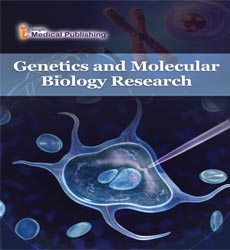Anatomy of COVID-19 Genetic and Molecular Approach
Jes Paul*
Department of Molecular & Cellular Physiology, Albany Medical College, USA
- Corresponding Author:
- Jes Paul
Department of Molecular & Cellular Physiology
Albany Medical College, USA
E-mail: jesrejoice@gmail.com
Receipt date: July 27, 2020; Revision date: July 28, 2020; Acceptance date: August 04, 2020
Citation: Paul J (2020) Anatomy of COVID-19 Genetic and Molecular Approach. Genet Mol Biol Res Vol No: 4 Iss No: 2:28
Copyright: © 2020 Paul J. This is an open-access article distributed under the terms of the Creative Commons Attributions License, which permits unrestricted use, distribution and reproduction in any medium, provided the original author and source are credited.
Keywords
COVID-19; Coronavirus; SARS-CoVs; MERS-CoV
Introduction
COVID-19 is a pneumonia-like disease. It is caused by a new coronavirus, named SARS-CoV-2; which is similar to Severe Acute Respiratory Syndrome (SARS) virus.
The interconnectedness across the world has been a boon for SARS-CoV-2. Without planes, trains and automobiles the virus wouldn’t have reached so far and fast. On the contrary interconnectedness may be its downfall, too. Because scientists across the globe are focusing on its genome and the 27 proteins that it is known to produce, gradually deepening their understanding and finding ways to stop it in its tracks.
Anatomy of COVID-19
At first the new virus was called 2019-nCoV. Subsequently, the researchers of International Committee on Taxonomy of Viruses (ICTV) termed it SARS-CoV-2 virus as it has been found to be similar to the one which caused the SARS outbreak (SARS-CoVs).
The CoVs have become the significant microorganisms of rising respiratory infection. CoVs are large family of singlestranded RNA viruses (+ssRNA) that can be isolated in different animal species. They can cause illness in humans ranging from the common cold to more severe diseases like MERS and SARS. SARS have most likely begun from bats and afterward moving into other mammalian hosts, for example, the Himalayan palm civet for SARS-CoV, and dromedary camel for MERS-CoV - before jumping to humans.
Etiology COVID-19
CoVs are positive-stranded RNA viruses with a crown-like structure when observed in electron microscope, because of presence of spike glycoproteins on envelope. There are 4 major categories of coronavirus: Alphacoronavirus (α-CoV), Betacoronavirus (β-CoV), Deltacoronavirus (-CoV), and Gammacoronavirus (ƴ-CoV). Only α & β coronaviruses able to infecting mammals/humans and as per genomic characterization it was revealed that bats and rodents are the gene sources of α-CoVs and β-CoVs. Avian species are found to be the gene sources of δ-CoVs and ƴ-CoVs and they tend to infect birds.
7 human coronaviruses (HCoVs) have been identified till date: HCoV-229E, HCoV-OC43, HCoV-NL63, HCoV-HKU1, SARSCoV (causes severe acute respiratory syndrome), MERS-CoV (Middle East respiratory syndrome) and now SARS-CoV-2.
SARS-CoV-2 belongs to the β-CoVs category. It is generally of round/elliptic or pleomorphic shape, with diameter ≈ 60-140 nm. It is also sensitive to UV light and heat, like other CoVs. The inactivation temperature of SARS-CoV-2 is about 27° C. On the contrary, it may also resist the cold below 0°C. Further, it can be inactivated by lipid solvents like ether (75%), ethanol, chlorine-containing disinfectant, peroxyacetic acid, and chloroform except for chlorhexidine.
It was discovered that the genome sequence of SARS-CoV-2 is 96.2% identical to a bat CoV RaTG13, whereas it shares 79.5% identity to SARS-CoV. Based on this virus genome sequencing results & evolutionary analysis, bat is suspected to be a natural host of this virus origination, and SARS-CoV-2 might have been transmitted from bats via unknown intermediate hosts to infect humans.
Coronavirus Genetics
Coronaviruses, this name has been coined as it looks like halos (known as coronas) under the electron microscope. Coronaviruses are a large family of RNA viruses. A typical generic coronavirus genome is a single strand of RNA, which is 32 kilobases long, and is known to be the largest RNA virus genome. These viruses recombine at a highest frequency than any other positive-strand RNA virus, wantonly consolidating genetic information from various sources when a host gets infected with multiple coronaviruses. In other words corona viruses mutate and change at a high rate, which results in a havoc for both diagnostic detection, and therapy (and vaccine) regimens.
Coronaviruses has a very unusual replication process, involving 2-step replication mechanism. A few RNA virus genomes contains a single open reading frame (ORF), which is then translated as a single polyprotein, this poly protein is catalytically cleaved into smaller functional viral proteins. But coronaviruses contains up to 10 individual ORFs. Most ribosomes translate the biggest one of these ORFs, called replicase, which is alone equivalent to twice the size of other RNA viral genomes. This replicase gene encodes a series of enzymes that utilize the remaining genome as a template to produce a combination of smaller, overlapping messenger RNA molecules, which are further translated to structural proteins (the building blocks of new viral particles).
Open Access Journals
- Aquaculture & Veterinary Science
- Chemistry & Chemical Sciences
- Clinical Sciences
- Engineering
- General Science
- Genetics & Molecular Biology
- Health Care & Nursing
- Immunology & Microbiology
- Materials Science
- Mathematics & Physics
- Medical Sciences
- Neurology & Psychiatry
- Oncology & Cancer Science
- Pharmaceutical Sciences
